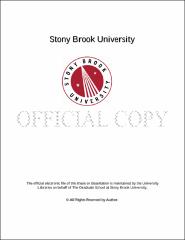| dc.identifier.uri | http://hdl.handle.net/11401/77120 | |
| dc.description.sponsorship | This work is sponsored by the Stony Brook University Graduate School in compliance with the requirements for completion of degree. | en_US |
| dc.format | Monograph | |
| dc.format.medium | Electronic Resource | en_US |
| dc.language.iso | en_US | |
| dc.publisher | The Graduate School, Stony Brook University: Stony Brook, NY. | |
| dc.type | Dissertation | |
| dcterms.abstract | 8-oxo-7,8,-dihydroguanine (oxoG) is one of the most prevalent DNA lesions, and has been linked to cancer and age-related diseases due to its ability to promote mutations. The oxoG damage can be removed by the Formamidopyrimidine-DNA glycosylase (Fpg) in prokaryotes and by human 8-oxoguanine glycosylase 1 (hOGG1) in human cells. Fpg and hOGG1 are structurally unrelated, but they have the same function of excising oxoG by extruding the oxoG out from the DNA helix into the enzyme's active site. Previous studies have revealed the damage recognition interactions in the active sites of these enzymes; however, their extremely fast diffusion rates along DNA almost exclude the possibility that they interrogate every encountered base in the active site. Thus, recognition of oxoG by Fpg and hOGG1 is hypothesized to occur not only at the active site, but also at the early stages of the base eversion pathway. All-atom molecular dynamics simulations were used to explore the oxoG recognition process during base eversion. Our simulations indicate that both Fpg and hOGG1 have several checkpoints for oxoG along the eversion pathway, and the geometries of those checkpoints are remarkably similar between the two enzymes, suggesting they employ similar strategies to efficiently detect oxoG from a sea of undamaged bases. | |
| dcterms.available | 2017-09-20T16:52:01Z | |
| dcterms.contributor | Schärer, Orlando | en_US |
| dcterms.contributor | Simmerling, Carlos | en_US |
| dcterms.contributor | Rizzo, Robert | en_US |
| dcterms.contributor | Garcia-Diaz, Miguel. | en_US |
| dcterms.creator | Li, Haoquan | |
| dcterms.dateAccepted | 2017-09-20T16:52:01Z | |
| dcterms.dateSubmitted | 2017-09-20T16:52:01Z | |
| dcterms.description | Department of Chemistry. | en_US |
| dcterms.extent | 142 pg. | en_US |
| dcterms.format | Monograph | |
| dcterms.format | Application/PDF | en_US |
| dcterms.identifier | http://hdl.handle.net/11401/77120 | |
| dcterms.issued | 2015-08-01 | |
| dcterms.language | en_US | |
| dcterms.provenance | Made available in DSpace on 2017-09-20T16:52:01Z (GMT). No. of bitstreams: 1
Li_grad.sunysb_0771E_12035.pdf: 12961072 bytes, checksum: 808075932a20fa4047634c18bf5ecb36 (MD5)
Previous issue date: 2014 | en |
| dcterms.publisher | The Graduate School, Stony Brook University: Stony Brook, NY. | |
| dcterms.subject | Chemistry | |
| dcterms.subject | 8-oxoguanine, base flipping, DNA damage, DNA glycosylases, molecular dynamics | |
| dcterms.title | Exploring DNA Damage Recognition Using Molecular Modeling | |
| dcterms.type | Dissertation | |

